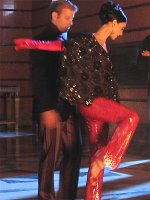
Night shooting is one of those crazy realities of making movies. Some filmmakers and crew thrive on it, others hate it. Roberto likes it. He describes the feeling of pleasure in creating while others are sleeping. Stephen, on the other hand, prefers weekday shoots with weekends and evenings off.
We're shooting on Saturday and overnight on Saturday, he says, shaking his head. At the same time, he is resigned. It was the only way to obtain the beautiful location: the lobby of a courthouse in downtown Hamilton.
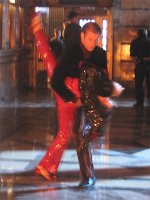
The setting serves as background for a midnight duet between the Pawnbroker and Roxana. Returning from a New Years' celebration, Roxana saunters through the lobby of her penthouse building, reflectively. The Pawnbroker catches up to her and entices her into a romantic dance in which the uncertainties and inevitabilities of their relationship are played out. The marble corridors and inlaid tile ceilings serve as an austere sign of the opulence in which she now lives. But at the same time the moonlight is a hint at the warmth or satisfaction she might also be missing.

While waiting, it was a great pleasure to finally catch up with costume designer Debra Hanson. (Here, she and Moze consider a piece of jewellery for Roxana's costume) Sipping a coffee, Debra describes the differences in working for film and working for theatre. Her credits in both are impressive to say the least, and our paths met some time ago when we both worked for the Stratford Festival. In the theatre, she explains, costume fittings are long and detailed, sometimes an hour or two to make sure they are right. In film, the designer is lucky to have fifteen or twenty minutes with the artist, and often close to the shoot itself. In theatre, clothes are designed to last eight or nine months of repertory performances and are built to be sturdy and endurable.
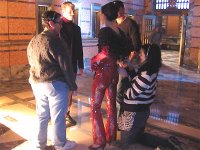
In film, budget constraints and the likely necessity of last minute adjustments and perhaps even no use at all mean the costumes are built to last only a few days. At the same time, the eye of the audience (the camera) is closer and more scrutinizing so they must be convincing. In a dance film, they must also be designed to allow for free movement. Roxana's jacket this evening, for instance, is made of a two-way stretch material, making dance movement possible.
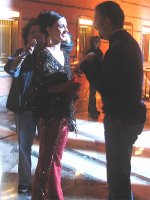
As we wait for picture up, the cold air wafts into the lobby through the only accessible doors and Moze looks on with concern about the potential loss of heat. Meanwhile nearby, dancer Rex Harrington who plays Roxana's lover Eliot, a politician, waits in costume, reading a paper. His entire call tonight is for one simple reaction shot which they must get at this location to his observation of the duet.
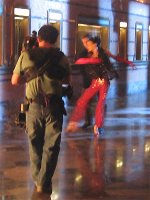
The duet sequence is being covered by a steadicam, a camera which is strapped to an operator who moves with it alongside the dancers. Tonight, the steadicam operator is Mike Meagher, being guided by Michael Spicer, the cinematographer, who calls out directions during takes and while the dance is occurring.
Breathe it out Mike, she's gaining on you! Immediately, the image on the monitor widens. Michael responds with
That's it! When the take is over, the camera is hastily put back on its stand, the weight of it clearly a relief for Mike to have off for a few seconds!

The duet is meant to continue into a surrealist sequence in which Roxana, moving through time, dances from one man to the other in a succession of encounters that also symbolically represent her upward movement in her own social sphere. The plan is for it to include a duet with a banker, played by Roberto, to be shot later in the night. The reverse wall of the courthouse corridor is perfect for the "hallway of power" indicated symbolically in the shooting schedule to represent this timeless transformation. However, scheduling is tight, and time is running out. In the end, it seemed likely that the duet between Roxana and the banker might have to be cut, though the rest of the sequence will remain in tact.
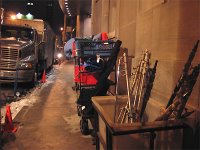
"Lunch" is called and while others hurry across the street, Moze chats with me quietly about how he might use this as an opportunity to do something different with his vision. During the next week, he will perhaps pick up a shot that covers the missing link, but will do so creatively, with a gesture or a very brief image or scene in which the steps in Roxana's rise may in fact also include a moment of her own reflection on it. In the end, he goes off to eat, still ruminating. I was reminded of Debra Hanson's comment about how movies are ongoingly creative. Even when the cameras have stopped rolling, the wheels are still turning and minds are still humming! While limitations do exist, it seems anything is still possible.
 Night shooting is one of those crazy realities of making movies. Some filmmakers and crew thrive on it, others hate it. Roberto likes it. He describes the feeling of pleasure in creating while others are sleeping. Stephen, on the other hand, prefers weekday shoots with weekends and evenings off. We're shooting on Saturday and overnight on Saturday, he says, shaking his head. At the same time, he is resigned. It was the only way to obtain the beautiful location: the lobby of a courthouse in downtown Hamilton.
Night shooting is one of those crazy realities of making movies. Some filmmakers and crew thrive on it, others hate it. Roberto likes it. He describes the feeling of pleasure in creating while others are sleeping. Stephen, on the other hand, prefers weekday shoots with weekends and evenings off. We're shooting on Saturday and overnight on Saturday, he says, shaking his head. At the same time, he is resigned. It was the only way to obtain the beautiful location: the lobby of a courthouse in downtown Hamilton.  The setting serves as background for a midnight duet between the Pawnbroker and Roxana. Returning from a New Years' celebration, Roxana saunters through the lobby of her penthouse building, reflectively. The Pawnbroker catches up to her and entices her into a romantic dance in which the uncertainties and inevitabilities of their relationship are played out. The marble corridors and inlaid tile ceilings serve as an austere sign of the opulence in which she now lives. But at the same time the moonlight is a hint at the warmth or satisfaction she might also be missing.
The setting serves as background for a midnight duet between the Pawnbroker and Roxana. Returning from a New Years' celebration, Roxana saunters through the lobby of her penthouse building, reflectively. The Pawnbroker catches up to her and entices her into a romantic dance in which the uncertainties and inevitabilities of their relationship are played out. The marble corridors and inlaid tile ceilings serve as an austere sign of the opulence in which she now lives. But at the same time the moonlight is a hint at the warmth or satisfaction she might also be missing. While waiting, it was a great pleasure to finally catch up with costume designer Debra Hanson. (Here, she and Moze consider a piece of jewellery for Roxana's costume) Sipping a coffee, Debra describes the differences in working for film and working for theatre. Her credits in both are impressive to say the least, and our paths met some time ago when we both worked for the Stratford Festival. In the theatre, she explains, costume fittings are long and detailed, sometimes an hour or two to make sure they are right. In film, the designer is lucky to have fifteen or twenty minutes with the artist, and often close to the shoot itself. In theatre, clothes are designed to last eight or nine months of repertory performances and are built to be sturdy and endurable.
While waiting, it was a great pleasure to finally catch up with costume designer Debra Hanson. (Here, she and Moze consider a piece of jewellery for Roxana's costume) Sipping a coffee, Debra describes the differences in working for film and working for theatre. Her credits in both are impressive to say the least, and our paths met some time ago when we both worked for the Stratford Festival. In the theatre, she explains, costume fittings are long and detailed, sometimes an hour or two to make sure they are right. In film, the designer is lucky to have fifteen or twenty minutes with the artist, and often close to the shoot itself. In theatre, clothes are designed to last eight or nine months of repertory performances and are built to be sturdy and endurable.  In film, budget constraints and the likely necessity of last minute adjustments and perhaps even no use at all mean the costumes are built to last only a few days. At the same time, the eye of the audience (the camera) is closer and more scrutinizing so they must be convincing. In a dance film, they must also be designed to allow for free movement. Roxana's jacket this evening, for instance, is made of a two-way stretch material, making dance movement possible.
In film, budget constraints and the likely necessity of last minute adjustments and perhaps even no use at all mean the costumes are built to last only a few days. At the same time, the eye of the audience (the camera) is closer and more scrutinizing so they must be convincing. In a dance film, they must also be designed to allow for free movement. Roxana's jacket this evening, for instance, is made of a two-way stretch material, making dance movement possible.  As we wait for picture up, the cold air wafts into the lobby through the only accessible doors and Moze looks on with concern about the potential loss of heat. Meanwhile nearby, dancer Rex Harrington who plays Roxana's lover Eliot, a politician, waits in costume, reading a paper. His entire call tonight is for one simple reaction shot which they must get at this location to his observation of the duet.
As we wait for picture up, the cold air wafts into the lobby through the only accessible doors and Moze looks on with concern about the potential loss of heat. Meanwhile nearby, dancer Rex Harrington who plays Roxana's lover Eliot, a politician, waits in costume, reading a paper. His entire call tonight is for one simple reaction shot which they must get at this location to his observation of the duet.  The duet sequence is being covered by a steadicam, a camera which is strapped to an operator who moves with it alongside the dancers. Tonight, the steadicam operator is Mike Meagher, being guided by Michael Spicer, the cinematographer, who calls out directions during takes and while the dance is occurring. Breathe it out Mike, she's gaining on you! Immediately, the image on the monitor widens. Michael responds with That's it! When the take is over, the camera is hastily put back on its stand, the weight of it clearly a relief for Mike to have off for a few seconds!
The duet sequence is being covered by a steadicam, a camera which is strapped to an operator who moves with it alongside the dancers. Tonight, the steadicam operator is Mike Meagher, being guided by Michael Spicer, the cinematographer, who calls out directions during takes and while the dance is occurring. Breathe it out Mike, she's gaining on you! Immediately, the image on the monitor widens. Michael responds with That's it! When the take is over, the camera is hastily put back on its stand, the weight of it clearly a relief for Mike to have off for a few seconds! The duet is meant to continue into a surrealist sequence in which Roxana, moving through time, dances from one man to the other in a succession of encounters that also symbolically represent her upward movement in her own social sphere. The plan is for it to include a duet with a banker, played by Roberto, to be shot later in the night. The reverse wall of the courthouse corridor is perfect for the "hallway of power" indicated symbolically in the shooting schedule to represent this timeless transformation. However, scheduling is tight, and time is running out. In the end, it seemed likely that the duet between Roxana and the banker might have to be cut, though the rest of the sequence will remain in tact.
The duet is meant to continue into a surrealist sequence in which Roxana, moving through time, dances from one man to the other in a succession of encounters that also symbolically represent her upward movement in her own social sphere. The plan is for it to include a duet with a banker, played by Roberto, to be shot later in the night. The reverse wall of the courthouse corridor is perfect for the "hallway of power" indicated symbolically in the shooting schedule to represent this timeless transformation. However, scheduling is tight, and time is running out. In the end, it seemed likely that the duet between Roxana and the banker might have to be cut, though the rest of the sequence will remain in tact.  "Lunch" is called and while others hurry across the street, Moze chats with me quietly about how he might use this as an opportunity to do something different with his vision. During the next week, he will perhaps pick up a shot that covers the missing link, but will do so creatively, with a gesture or a very brief image or scene in which the steps in Roxana's rise may in fact also include a moment of her own reflection on it. In the end, he goes off to eat, still ruminating. I was reminded of Debra Hanson's comment about how movies are ongoingly creative. Even when the cameras have stopped rolling, the wheels are still turning and minds are still humming! While limitations do exist, it seems anything is still possible.
"Lunch" is called and while others hurry across the street, Moze chats with me quietly about how he might use this as an opportunity to do something different with his vision. During the next week, he will perhaps pick up a shot that covers the missing link, but will do so creatively, with a gesture or a very brief image or scene in which the steps in Roxana's rise may in fact also include a moment of her own reflection on it. In the end, he goes off to eat, still ruminating. I was reminded of Debra Hanson's comment about how movies are ongoingly creative. Even when the cameras have stopped rolling, the wheels are still turning and minds are still humming! While limitations do exist, it seems anything is still possible.

0 Comments:
Post a Comment
<< Home